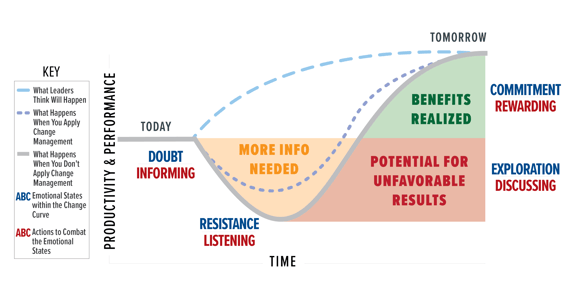Understanding the Emotional Side of Change, Part 2
This is part two of a two-part blog series by Avaap Senior Consultant, Dr. Brandon Rogers, PMP, PMI-ACP. Part one looked at introducing the change curve and why it matters.
Part 2: Exploration and Commitment
In our previous post, we discussed leading change efforts by using the change curve to resolve the doubt and resistance emotional stages that come with implementing sustainable change. The change curve identifies the balance between productivity, performance, and the time horizon for implemented change (today) and benefits realized (tomorrow).
Continuing to navigate the Change Curve
 Change leaders measure the sentiment of employees by viewing the curve from the perspective of emotional response. Beyond the early phases of doubt and resistance, the undercurrent of potential for unfavorable results still exists, and must be considered and addressed before benefits of a change can be realized. We discussed two-way dialog in our last post, and recommend continuing with this strategy after the dip and disruption. When employees have the opportunity for exploration, they start to understand the change and why it is happening. Once employees understand, and see real benefits to them and the organization, they are more willing to commit to the change — often becoming champions of the change.
Change leaders measure the sentiment of employees by viewing the curve from the perspective of emotional response. Beyond the early phases of doubt and resistance, the undercurrent of potential for unfavorable results still exists, and must be considered and addressed before benefits of a change can be realized. We discussed two-way dialog in our last post, and recommend continuing with this strategy after the dip and disruption. When employees have the opportunity for exploration, they start to understand the change and why it is happening. Once employees understand, and see real benefits to them and the organization, they are more willing to commit to the change — often becoming champions of the change.
Creating a future together
To enable successful change, it is critical for employees to understand why the change is occurring, and to feel as though they have a valued part in the change process. While we advocate for involving key stakeholders from all areas of the company, it is wise to include even the smallest of change sponsors and champions in transformation planning and implementation.
Research shows that organizations with at least seven percent of employees engaged in the change process are two times more likely to yield positive outcomes than those organizations where employees were not engaged and felt that a change was imposed upon them.
During the exploration phase, change leaders should encourage open and candid dialog with their teams. Employees should be given a platform to ask difficult questions to understand the risks, and to learn what the direct impact to their day-to-day work will be, and what, if any, mitigation strategies exist to tackle potential issues head-on. By considering these aspects, leaders and employees begin to ideate solutions and options for moving forward, together.
From a leadership perspective, the ideal approach is to give context around the way things will look once the change is successfully implemented. You’re switching from your role as the active listener in the resistance phase to change champion. It is now your role to “sell” the benefits of the change processes, and the value to the people and the future of the business.
As the phase of exploration ends, benefits may start to be realized, and once your team crosses that threshold, commitment sets in. Committed employees will adopt the change and help advocate it to others for even greater and earlier adoption across the organization. Be sure to reward successes and celebrate the accomplishments of your team.
Take time to reflect and capture lessons learned to integrate valuable takeaways for continuous improvement. These actions will leave a positive, lasting impression on your employees and will set you up for a more streamlined transition the next time change happens.
Businesses must adapt and evolve — sometimes sooner than anticipated due to unexpected market forces. Retaining employees with positive change experiences will create a stronger culture for welcoming future change rather than fearing it, ultimately reducing the time spent in the disruptive dip.
Leaders must continue to recognize and adequately prepare for rapid transformation. Tools like the change curve and other research-based methods (emotional intelligence, contextual intelligence, etc.) can help to address many of the concerns that often paralyze leaders.
We operate under the philosophy that organizations don’t change, people do. Change can be difficult and experienced change practitioners help leaders work through the process. To successfully manage change, it is critical to understand and acknowledge the emotional journey employees face before, during, and after any change initiative. Unless employees embrace the change, the disruption dip will be longer, benefits won’t be realized, employee retention will suffer, and bottom lines will be negatively impacted.
Avaap helps organizations navigate, manage, and implement change. We have deep experience supporting organizational change initiatives and helping employees understand change, drive commitment, and contribute to organization success. What can change management do for you? Let’s chat and find out!

